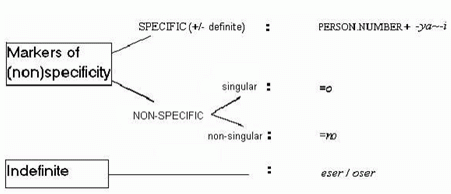Syntax: noun phrases
Nouns combine with other elements in order to function as ‘referring expressions’ or noun phrases. The simplified structure of the noun phrase is as follows, where the noun is the head:
noun ((numeral linker) numeral) article
The function of the pronominal article is, as it were, to indicate the status of the referring expression within the world of discourse. More specifically, the article indicates:
- whether the referent of the noun phrase is a speaker, addressee, or third person, and whether it is singular or plural.
- whether the noun phrase is specific or nonspecific, or possibly indefinite
- whether the referent is ‘given’ in the world of discourse.
This can be depicted as in the following figure, which indicates the functions of the different pronominal articles, as well as how they are formed.

For an explanation of the notion of givenness, the reader is referred to Van den Heuvel (2006), 213f. The notion of specificity, however, will be explained below.
It should be noted that the basic distinction within Biak noun phrases is not between definite and indefinite sentences, but between specific and nonspecific. With the use of a specific marker, a Biak speaker indicates that (s)he refers to an entity that can, in principle, be identified by the Speaker. The entity that is referred to, then, exists as a ‘finished’ and ‘well-bound’ entity. The following sentences illustrate clearly that specificity cross-cuts the notion of definiteness as it exists, for example, in English. Sentence (1) is part of a story, where the main participant enters into a cave Then there suddenly appears to be a snake:
(1) |
Fama |
ikakya |
vyark |
wark |
i |
|
fama |
ikak=ya |
v<y>ark |
wark |
i |
|
however |
snake=3sg.spc |
<3sg>ly |
block |
3sg |
|
‘But there was a snake, lying and blocking it!’ |
||||
Because the snake has not been introduced into the story yet, and is not known to the Addressee(s) of the story yet, the English language needs to use an indefinite pronoun to refer to it. The Biak, language, however, uses a specific pronoun. This is because the snake, as soon as it has been introduced in the story, exists as an entity that is principally identifiable, at least for the speaker. The function of specific and nonspecific markers can further best be illustrated by showing the contexts in which nonspecific markers are used. Nonspecific markers are used in the following cases:
- When the entity does not yet exist as a well-bound and identifiable entity
- When the existence of an entity is questioned.
- When the existence of the entity marked as nonspecific is negated.
An example of context (a) is given in (2), which forms a minimal pair with (3). The sentence was used by a person who was busy making tea. In this context, the use of the nonspecific marker implied that the tea was not ready yet. The use of the specific marker, illustrated in (3), implies that the tea has been made already; it exists or existed as a bound entity.
(2) |
Yafur |
teyo |
fa |
kuyinem |
|
ya-fur |
te=yo |
fa |
kuy-inm |
|
1sg |
tea=nonsp.sg |
cons |
1du.inc-drink |
|
'I am making tea so that the two of us can drink' |
|||
(3) |
Yafur |
teya |
fa |
kuyinem |
|
ya-fur |
te=ya |
fa |
kuy-inm |
|
1sg |
tea=3sg.spc |
cons |
1du.inc-drink |
|
'I (had) made tea so that the two of us could drink' |
|||
Another example illustrating this function is given with (3), where the speaker does not have a specific person in mind to fell the trees:
(4) |
Eser=o |
kyar |
monda |
|
|
eser=o |
k<y>ar |
monda |
|
|
one=nonsp.sg |
<3sg>fell |
just |
|
|
'Let just one fell trees' |
|||
An example of the use of a nonspecific to question an entity’s existence (context b above) is given in (5):
(5) |
Foro |
isya |
be |
ma |
yakpam |
ari |
|
for=o |
is=ya |
be |
ma |
ya-k-pam |
ari |
|
fire=nonsp.sg |
3sg.pred-that |
2sg.give |
to.here |
1sg-use-light |
first |
|
‘If there is fire, give me some, so that I can use it to light (my cigarette) first.’ |
|||||
An example of negation, finally, is given with the following sentence:
(6) |
Kosmai |
roino |
fa |
kan |
va |
|
|
ko-smai |
ro=no |
fa |
kan |
va |
|
|
1pl.ex-cut |
thing=nonsp.nonsg |
cons |
1pl.inc-eat |
not |
|
|
‘We do not have anything to eat’. |
|||||








